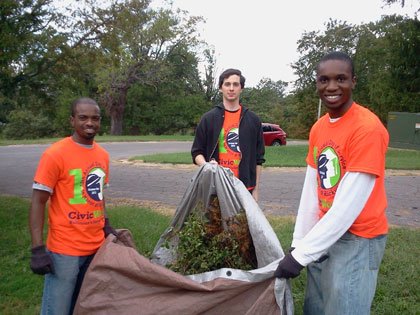BALTIMORE — For 21 years, Earl Millett has carefully watched how the nonprofit Civic Works has strengthened Baltimore communities through job training, volunteerism and how the organization has changed many lives by providing job readiness, life skills, education and helping the underserved secure and maintain suitable employment.
“Civic Works really got started based on the idea of creating a service in Baltimore, especially for the youth,” said Millett, the nonprofit’s chief operating officer who has worked with Civic Works for eight years.
Millett says the more than two decades-old organization has always been committed to service and delivering results that helps to make a change in the lives of many. Each year, more than 200 residents join Civic Works as AmeriCorps members, which further shows their commitment to service.
“I have been able to service multiple homes and meet a lot of people and my responsibilities include educating residents on how they can make their homes more energy efficient, and installing energy efficient items,” said Maya, a local resident and AmeriCorps volunteer. “I joined AmeriCorps to take advantage of the opportunities to help others reduce paying high utility bills. Another reason I joined the program is because I like to speak to residents and connect them with information and resources that they do not know about and, I knew by joining Civic Works’ AmeriCorps program, I could make a change in Baltimore City.”
Like each of the volunteers, Maya received hands-on training and on the job experience and she said she could really see the difference in the lives of the residents receiving the service.
“I was once told that helping others in need is the most selfless act an individual can do and during my time with Civic Works as an AmeriCorps member, I have come to realize that this statement is absolutely true,” said Kristopher, another local volunteer.
“After graduating from college, I moved back to Baltimore in hopes of just finding something to do in between my transition to graduate school. Beginning in the summer of 2013, I started my first term with the Project Lightbulb team. Over the course of the term my supervisors introduced daily tasks forcing me to step out of my comfort zone and trying my best at perfecting the duties put in front of me enabled me to enhance my communications and presentation skills.”
Kristopher also noted that understanding how AmeriCorps and Civic Works positively affect the community has allowed him to see why service is so important in rebuilding Baltimore.
On Saturday, October 11, 2014, Civic Works will hold its annual Ricky Myers Day of Service at Clifton Mansion in Clifton Park.
The service day, which is named after Myers who worked with Civic Works as a crew leader on a summer waterway cleanup project, annually attracts hundreds of volunteers who clean area parks and vacant lots, plant trees, paint schools, repair homes for elderly residents, create community gardens, and help conserve energy.
“It’s an opportunity for us on this day to help, to tutor and mentor,” Millett said, adding that this year’s event should attract between 400 and 500 volunteers. “It’s amazing how much we can get done in such a short period of time when we have so many people working together for a common cause. With a group of this size, we get to see dramatic changes on that day and it really helps to inspire and motivate so many people.”
Emily Slaughter, the Fund Development Coordinator for Civic Works says volunteers at the event will receive a light breakfast, t-shirts, lunch and other perks.
During the 2013 “Day of Service,” volunteers planted 90 trees and 3,500 flower bulbs, Slaughter said in a news release. Also, two abandoned lots were converted into green space and the volunteers also helped to improve classrooms at two local schools, they cleaned three public parks and made improvements to an urban farm.
“The idea of that community spirit among those providing the service and those receiving is amazing,” Millett said. “It’s always hard to tell who is benefiting the most, the volunteers or the recipients of the volunteer effort.”
